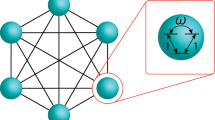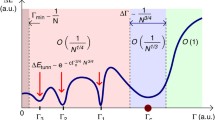Abstract
A non-Hermitian quantum optimization algorithm is created and used to find the ground state of an antiferromagnetic Ising chain. We demonstrate analytically and numerically (for up to \(N=1,024\) spins) that our approach leads to a significant reduction in the annealing time that is proportional to \(\ln N\), which is much less than the time (proportional to \(N^2\)) required for the quantum annealing based on the corresponding Hermitian algorithm. We propose to use this approach to achieve similar speed-up for NP-complete problems by using classical computers in combination with quantum algorithms.






Similar content being viewed by others
References
Kadowaki, T., Nishimori, H.: Quantum annealing in the transverse Ising model. Phys. Rev. E 58(5), 5355 (1998)
Farhi, E., Goldstone, J., Gutmann, S., Lapan, J., Lundgren, A., Preda, D.: A quantum adiabatic evolution algorithm applied to random instances of an np-complete problem. Science 292(5516), 472 (2001)
Suzuki, S., Okada, M.: Quantum annealing and related optimization methods. In: Das, A., Chakrabarti, B.K. (eds.) Lecture Notes in Physics, vol. 679, pp. 207–238, Springer, Berlin (2005)
Das, A., Chakrabarti, B.K.: Quantum annealing and analog quantum computations. Rev. Mod. Phys. 80(3), 1061 (2008)
Santoro, G.E., Martonak, R., Tosatti, E., Car, R.: Theory of quantum annealing of an Ising spin glass. Science 295, 2427 (2002)
Quantum quenching, annealing and computation. In: Chandra, A.K., Das A., Chakrabarti B.K. (eds.) Lecture Notes in Physics, vol. 802. Springer, Berlin (2010)
Stella, L., Santoro, G.E., Tosatti, E.: Phys. Rev. B 72, 014303 (2005)
Suzuki, S., Nishimori, H., Suzuki, M.: Quantum annealing of the random-field Ising model by transverse ferromagnetic interactions. Phys. Rev. E 75, 051112 (2007)
Amin, M.H.S.: Effect of local minima on adiabatic quantum optimization. Phys. Rev. Lett. 100(13), 130503 (2008)
Smelyanskiy, V.N., Toussaint, U. v, Timucin, D.A.: Dynamics of quantum adiabatic evolution algorithm for Number Partitioning, arXiv: quant-ph/0202155
Jörg, T., Krzakala, F., Kurchan, J., Maggs, A.C.: Simple glass models and their quantum annealing. Phys. Rev. Lett. 101(14), 147204 (2008)
Young, A.P., Knysh, S., Smelyanskiy, V.N.: First-order phase transition in the quantum adiabatic algorithm. Phys. Rev. Lett. 101, 170503 (2008)
Berman, G.P., Nesterov, A.I.: Non-Hermitian adiabatic quantum optimization. IJQI 7(8), 1469 (2009)
Nesterov, A.I., Berman, G.P.: Quantum search using non-Hermitian adiabatic evolution. Phys. Rev. A 86, 052316 (2012)
Nesterov, A.I., Beas Zepeda, J.C., Berman, G.P.: Non-Hermitian quantum annealing in the ferromagnetic Ising model. Phys. Rev. A 87, 042332 (2013)
Lieb, E., Schultz, T., Mattis, D.: Two soluble models of an antiferromagnetic chain. Ann. Phys. 16(5), 407 (1961)
Katsura, S.: Statistical mechanics of the anisotropic linear Heisenberg model. Phys. Rev. 127, 1508 (1962)
Schultz, T.D., Mattis, D.C., Lieb, E.H.: Two-dimensional Ising model as a soluble problem of many fermions. Rev. Mod. Phys. 36, 856 (1964)
McCoy, B.M.: Phys. Rev. 173, 531 (1968)
Barouch, E., McCoy, B.M.: Statistical mechanics of the XY model. II. Spin-correlation functions. Phys. Rev. A 3, 786 (1971)
Nesterov, A.I., Ovchinnikov, S.G.: Geometric phases and quantum phase transitions in open systems. Phys. Rev. E. 78(1), 015202(R) (2008)
Landau, L., Lifshitz, E.M.: Quantum Mechanics. Pergamon, New York (1958)
Zener, C.: Non-adiabatic crossing of energy levels. Proc. R. Soc. A 137, 696 (1932)
Zhang, L., Kou, S.P., Deng, Y.: Quench dynamics of the topological quantum phase transition in the Wen-plaquette model. Phys. Rev. A 83, 062113 (2011)
Cherng, R.W., Levitov, L.S.: Entropy and correlation functions of a driven quantum spin chain. Phys. Rev. A 73, 043614 (2006)
Cincio, L., Dziarmaga, J., Rams, M.M., Zurek, W.H.: Entropy of entanglement and correlations induced by a quench: Dynamics of a quantum phase transition in the quantum Ising model, cond-mat/0701768. Phys. Rev. A 75, 052321 (2007)
Dziarmaga, J.: Dynamics of a quantum phase transition: Exact solution of the quantum Ising model. Phys. Rev. Lett. 95(24), 245701 (2005)
Erdélyi, A., Magnus, W., Oberhettinger, F.: Higher Transcendental Functions, vol. I. McGraw-Hill, New York (1953)
Ohzeki, M., Nishimori, H.: Quantum annealing: An introduction and new developments. J. Comp. Theor. Nanoscience 8, 963 (2011)
Ohzeki, M.: Quantum annealing with the Jarzynski equality. Phys. Rev. Lett. 105, 050401 (2010)
Ohzeki, M., Nishimori, H.: Quantum annealing with Jarzynski equality. Comp. Phys. Comm. 182, 257 (2011)
Utsunomiya, S., Takata, K., Yamamoto, Y.: Mapping of Ising models onto injection-locked laser systems. Optics Express 19, 18091 (2011)
Takata, K., Utsunomiya, S., Yamamoto, Y.: Transient time of an Ising machine based on injection-locked laser network. New J. Phys. 14, 013052 (2012)
Acknowledgments
The work by G.P.B. and A.R.B. was carried out under the auspices of the National Nuclear Security Administration of the U.S. Department of Energy at Los Alamos National Laboratory under Contract No. DE-AC52-06NA25396. A.I.N. acknowledges the support from the CONACyT, Grant No. 15439. J.C.B.Z. acknowledges the support from the CONACyT, Grant No. 171014.
Author information
Authors and Affiliations
Corresponding author
Appendices
Appendix A: One-dimensional antiferromagnetic Ising chain in a transverse field
We consider the 1-dimensional antiferromagnetic Ising chain in a transverse magnetic field governed by the following non-Hermitian Hamiltonian:
with the periodic boundary condition, \({\varvec{\sigma }}_{N+1} ={\varvec{\sigma }}_1\). The external magnetic field is associated with the parameter, \(g\), the spontaneous decay is described by the parameter, \(\delta \).
The non-Hamiltonian in Eq. (56) can be diagonalized using the standard Jordan-Wigner transformation, following well-known procedures described in [16–20] for Hermitian Hamiltonians. Note that, the diagonalization of the non-Hermitian Hamiltonians requires one to deal with some additional mathematical obstacles. For instance, in the non-Hermitian case the right and the left eigenvectors are different, and generally one has a complex energy spectrum.
The Jordan-Wigner transformation, which is mapping of a spin-1/2 system to a system of spinless fermions, is given by
in which the \(c_n\) are fermionic operators that satisfy anticommutation relations: \(\{c^\dagger _m,c_n\} = \delta _{mn}\) and \(\{c_m,c_n\}=\{c^\dagger _m,c^\dagger _n\}=0\). Applying these transformations, we obtain
The periodic boundary condition imposed on the spin operators leads to the following boundary condition for the fermionic operators:
\({{\fancyscript{N}}}_F = \sum ^N_{n=1} c^\dagger _{n} c^\dagger _{n}\) being the total number of fermions. From Eq. (57) it follows that \({{\fancyscript{N}}}_F= N/2- S^x\), where \(S^x\) is the total \(x\)-component of the spins. For the particular choice of parameters, \(g=\delta =0\), we obtain, \(S^x =0\) and \({{\fancyscript{N}}}_F= N/2\). Thus, for \(S^x =0\) and \({{\fancyscript{N}}}_F= N/2\) we obtain periodic (antiperiodic) boundary conditions if \(N/2\) is odd (even). Note that since the parity of the fermions is conserved, the imposed boundary conditions are valid for all values of the parameters, \(g\) and \(\delta \).
Next, by applying the Fourier transformations,
we find that the Hamiltonian (60) can be recast in Fourier space as follows:
where \({\tilde{g}} = g+i\delta \) and \(\varphi _k = {2\pi k}/{N}\). For periodic boundary conditions, \(c_{N+1}=c_1\), the wave number, \(k\), takes the following discrete values:
and for antiperiodic boundary conditions, \(c_{N+1}=-c_1\), we obtain
In what follows, we impose the antiperiodic boundary conditions for the fermionic operators.
The Hamiltonian, \(H\), can be diagonalized using the generalized Bogoliubov transformation [14, 21]. Its spectrum is given by \(\varepsilon _{\pm }(k)= \varepsilon _{0} \pm \varepsilon _k\), in which \(\varepsilon _{0} = J\cos \varphi _k- iJ\delta \), and \( \varepsilon _k = J\sqrt{{\tilde{g}}^2 - 2{\tilde{g}}\cos \varphi _k +1}\). There are two (right) eigenstates for each \(k\),
in which
with \(\theta _k\) being a complex angle.
Since for each \(k\), the ground state lies into the two-dimensional Hilbert space spanned by \(|0\rangle _k |0\rangle _{-k}\) and \(|1\rangle _k |1\rangle _{-k}\), it is sufficient to project \(H\) onto this subspace. For a given value of \(k\), both of these states can be represented as a point on the complex two-dimensional sphere, \(S^2_c\). In this subspace, the Hamiltonian, \(H_k\), takes the form
Its ground state can be written as a product of qubit-like states, \(|\psi _g\rangle = \bigotimes _{k}|u_{-}(k)\rangle \), so that:
where, \(|0\rangle _k \), is the vacuum state of the mode \(c_k\), and \(|1\rangle _k \) is the excited state: \(|1\rangle _k =c^\dagger _k |0\rangle _k\).
For \(|{\tilde{g}}|\gg 1\), the ground state is paramagnetic with all spins oriented along the \(x\) axis. From Eq. (68), we obtain \(\cos \theta _k \rightarrow - 1\) as \(|{\tilde{g}}| \rightarrow \infty \). From here, it follows that, \(|u_{-}(k)\rangle \rightarrow \left( \begin{array}{c} 1 \\ 0 \\ \end{array} \right) \). Thus, the north pole of the complex Bloch sphere corresponds to the paramagnetic ground state. On the other hand, when \(|g|\ll 1\) there are two degenerate antiferromagnetic ground states with neighboring spins polarized in opposite directions along the \(z\)-axis. The real part of the complex energy reaches its minimum at the point defined by \(\cos \theta _k = 1\), and hence, the south pole of the complex sphere is related to the pure antiferromagnetic ground state.
Appendix B: Exact solution of the non-Hermitian Landau-Zener problem
The non-Hermitian Hamiltonian, \( {\fancyscript{H}}(t)\), projected on the two-dimensional subspace spanned by \(|k_1\rangle = { \left( \begin{array}{c} 1 \\ 0 \\ \end{array} \right) }\) and \(|k_0\rangle ={ \left( \begin{array}{c} 0 \\ 1 \\ \end{array} \right) }\), takes the form
where \(\varepsilon _0(t)= J\cos \varphi _k-iJ\delta (t)\) and \({\tilde{g}}(t) = g(t) + i\delta (t)\). We assume a linear dependence of the function, \({\tilde{g}}(t)\), on time:
where, \(\gamma =(g+i\delta )/\tau \), and \(g,\,\delta \) are real parameters.
The general wave functions, \(|\psi _k\rangle \) and \(\langle \tilde{\psi }_k |\), satisfy the Schrödinger equation and its adjoint equation
Presenting \(|\psi _k(t)\rangle \) as a linear superposition
and inserting (76) into Eq. (74), we obtain
Let \(z_k(t) = \hbox {e}^{i\pi /4}\sqrt{2J/\gamma }\big (\gamma (\tau -t)-\cos \varphi _k\big )\) be a new variable. Then, for new functions, \(u_k(t)= U_k(z_k)\) and \(v_k(t) = V_k(z_k)\), we obtain
where \(\nu _k= (J/2\gamma )\sin ^2 \varphi _k\), and the complex ‘time’ \(z_k\) runs from \(z_k(0) = \hbox {e}^{i\pi /4}\sqrt{2J/\gamma }\big (\gamma \tau -\cos \varphi _k\big )\) to \(z_k(\tau ) = -\hbox {e}^{i\pi /4}\sqrt{2J/\gamma }\cos \varphi _k\).
From Eqs. (79), (80), we obtain the second order Weber equations
Solution of the Weber’s equations is given by the parabolic cylinder functions, \(D_{-i\nu _k}(\pm z)\) and \(D_{i\nu _k-1}(\pm i z)\).
We obtain the solutions of Eqs. (79), (80) in the form
where the constants, \(A_k\) and \(B_k\), are determined from the initial conditions.
Rights and permissions
About this article
Cite this article
Nesterov, A.I., Berman, G.P., Zepeda, J.C.B. et al. Non-Hermitian quantum annealing in the antiferromagnetic Ising chain. Quantum Inf Process 13, 371–389 (2014). https://doi.org/10.1007/s11128-013-0656-z
Received:
Accepted:
Published:
Issue Date:
DOI: https://doi.org/10.1007/s11128-013-0656-z




